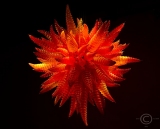- Forum
- General Discussion | Introductions | Off Topic Forum
- Photography General Discussion
- Exposure metering by the camera
Exposure metering by the camera
-
 Topic Author
Topic Author
- AzrielY
- Newbie
- Follower: 1
-
Points:
270
Post #703517
I take two pictures of the same exact object (say a picture on a wall) with same exact lighting conditions. First shot is with the lens set to 100mm focal length, then i step back to double the distance to the object and set the zoom to 200mm focal length so as to get the same exact composition as before. The camera sets the exposure for both shots at exactly the same value. And the images look identical.
HOW CAN THAT BE?
Doesn't that contradict the fact that light reflected by the object looses its intensity by square of the distance between the object and the camera sensor? I mean that's basic physics... So where did i get it wrong?
-

- Nikon Shooter
- Oh Wise One
-
- 3S 3X 810 850
- Followers: 197
- Posts: 13795
-
Points:
88932
Post #703532
but that doesn't means that something went wrong. There
are three values in the exposure triangle and one, or more,
MUST have change to adapt to the lighting conditions.
Check all three: SS, ƒ, and ISO.
Light is free… capturing it is not!
-
 Topic Author
Topic Author
- AzrielY
- Newbie
- Follower: 1
-
Points:
270
Post #703706
That's exactly my point: All three values remained exactly the same for both shots. SS 125, f4.0 and ISO 2500. The only thing different was the focal length and the distance to object.
I used Canon 5d M4 with Canon 70-200 f4.0 Lens. But i really don't think it is important which equipment you use. Its the principal that puzzles me.
Its a simple enough experiment, you can repeat it if you have a few spare minutes...
-

- Ozzie_Traveller
- Apprentice
-
- Currently using a Panny FZ-300 and FZ-2500 with occasional use of a Panny mirrorless G-series
- Followers: 124
- Posts: 2713
-
Points:
54251
Post #703754
I am not sure as to exactly what point you are trying to make here
As someone who has been using SLRs since the 1960s, I have been metering "millions" of frames over thousands of subjects ..........
It is quite feasible that a 'close-up' metering of an object will be the same as a 'distant' metering of the same object under many circumstances. Equally, it is quite normal to find that a 'close-up' metering of an object becomes different once one moves back from that object and the lens / camera starts to see other parts of the scene
Introducing the inverse-square-law does not arise here, as the objects being photographed are / seem to be / part of a wider scene illuminated from a light source (the sun?) ie- so far away that light falling on the scene appears uniform
Phil from the great land Downunder
www.flickr.com/photos/ozzie_traveller/sets/
-

- John Landolfi
- Super User
-
- Nikon D3S, D7100, Sony RX10, Canon G11, F4s, F2sb, RetinaflexIV etc, etc
- Followers: 1205
- Posts: 21605
-
Points:
40394
Post #703756
-
 Topic Author
Topic Author
- AzrielY
- Newbie
- Follower: 1
-
Points:
270
Post #704550
Thank you for your response.
I'm really not trying to make a point. Just seeking an answer to a question.
In both shots the viewing angle of the lens was adjusted so that the composition (in this case a picture on the wall) will be exactly the same, filling the entire aperture. So the image projected on the camera sensor is the same. Since i have doubled the distance to subject, and zoomed in, the view angle was reduced by approximately a factor of two. I would argue that in both cases the camera "sees" the same scene. Meaning that the light creating the image on the camera sensor has come from the same exact object. As the distance to the object was doubled, i would expect the light power to drop by a factor of 2 - in other words a hole stop of the exposure. But, it does not: the camera metering shows the same exact values for both shots and amazingly enough the images themselves look identically exposed!
Not that this upsets my work in any way, i just find this puzzling.
By the way i used spot metering keeping the metered spot at the center of the scene in both shots.
-
 Topic Author
Topic Author
- AzrielY
- Newbie
- Follower: 1
-
Points:
270
- Forum
- General Discussion | Introductions | Off Topic Forum
- Photography General Discussion
- Exposure metering by the camera
Latest Reviews
The Canon EOS R100 is an entry-level mirrorless camera introduced in 2023. But just because it’s an entry-level camera doesn’t mean it’s a bare-bones camera. Find out why in this review!
Nikon’s retro-looking Nikon Zfc is anything but retro. Under its classic body is a host of features and amenities that make it a worthwhile compact mirrorless camera for 2024.
The Canon EOS R50 is one of the newest R-system cameras from Canon. Is it worth your money? Find out all the details you need to know in this comprehensive review.
The Sony FE 70-200mm f/2.8 GM OSS II is Sony’s flagship mirrorless zoom lens. As such, it’s loaded with features and has a top-shelf build quality that makes it a top pick!
Forum Top Posters
-
1TCav 6 posts
-
2Prago 4 posts
-
3Foggy 4 posts
-
4Sandy Smith Photos 3 posts
-
5Razky 3 posts
-
6No Show 3 posts
-
7CaptNemo 3 posts
-
8db3348 3 posts
-
9Scotty 3 posts
-
10Rob Conley 2 posts
Latest Articles
Creating impactful photos of landscapes depends on many factors, not the least of which is your talent behind the lens. This guide explores other elements required for the best product.
The Canon EOS R100 is an entry-level mirrorless camera introduced in 2023. But just because it’s an entry-level camera doesn’t mean it’s a bare-bones camera. Find out why in this review!
Are you ready to upgrade your camera? Before buying new, you might consider the value of purchasing used gear to save money.
The Olympus OM-D E-M10 Mark IV is a micro four thirds camera released in 2020. It’s an entry-level system along with the OM-D E-M5 Mark III. Use this guide to determine which one is best for you!
Blue hour photography might not be as well known as golden hour photography, but it is every bit as good a time to create epic images of landscapes. Learn how in this quick tutorial!
Nikon’s retro-looking Nikon Zfc is anything but retro. Under its classic body is a host of features and amenities that make it a worthwhile compact mirrorless camera for 2024.
Moving from taking snapshots of your dog to creating beautiful images doesn’t have to be that difficult! Use the tips outlined in this dog photography guide, and you’ll get better results in no time.
Acrylic print photos are a beautiful way to display your favorite images. But they don’t come without some questions. Get all the answers you need about this medium in this guide!
















